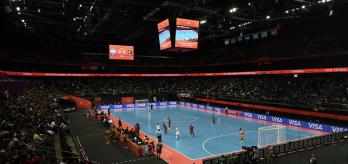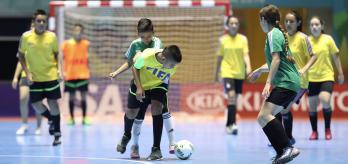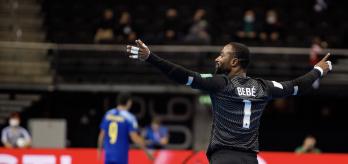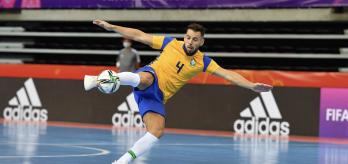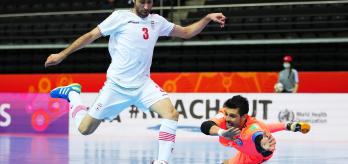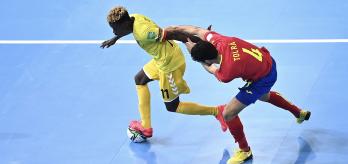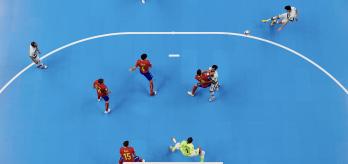Introduction
Although the importance of set plays within game play is not a new phenomenon, in this World Cup we saw a varied approach – in particular to corners. That said, the TSG, in looking for specific trends, noted a general lack of innovation in set plays. It found that traditional corner set-ups – those deployed for more than three decades – are still being adopted, with teams still unable to find satisfactory defensive set-ups to thwart them.
This was evident throughout all stages of the competition with teams, when facing a corner, still unable to anticipate, for instance, a traditional type of delivery such as the lofted ball to the far post for an aerial volley. If these longstanding set-play routines are not defended effectively then, of course, they will remain a favoured option. In this sense, it will take better defensive actions to force innovation, with one driving the other.
The more successful teams have a tendency to take quick corners and capitalise on the unorganised state of their opponents, ensuring the surprise element and taking advantage of their own superior organisation for a quick pass and shot routine. This requires intelligence, awareness and proactivity in possession. Iran demonstrated this approach against Serbia albeit their plays were somewhat predictable and would have benefitted from better innovation and disguise. For their part, Portugal, Argentina and Russia applied speed of thought to profit from disorganised defences and get the ball back into play quickly. Could this approach be helped by better physical preparation, enabling teams to get on with play when their opponents still need time to reorganise and recover?
Key data
Set-plays accounted for almost one-third of the 301 goals scored in the tournament, with 92 in total: 32 kick-ins, 29 corners, 26 free kicks, 3 (6m) penalties and 2 (10m) free kicks. Yet with improved technical preparation and greater innovation this total could have been more given the number of set-plays awarded. The importance of set-plays to match outcomes is well known and the TSG formed the opinion that there were many wasted opportunities from corners during the competition.
An astonishing 947 corners were awarded across the 52 games played but they produced just 29 goals – a success rate of 3.1%. The data supports the perception that a lack of innovation and poor execution at set-plays inhibits outcomes and the in-possession opportunities presented by corners are being lost. Corners offer a structured opportunity that few nations managed to maximise.
Principles
Set-plays are reliant upon three key controlling principles: delivery, positioning and movement. The out-of-possession positioning of the opponent is a factor that is uncontrollable to some extent though initial in-possession positioning can influence the start point and actions of the defending side. In many instances, because teams only demonstrated a small ‘library’ of set-play routines at corners, their efforts became somewhat routine. Those teams who succeeded (i.e. scored goals) had clear options at each set-play and the TSG's view is that a team should have two or three options depending on how the opposition set up their defensive structure. Evidently, this requires an innovative approach to coaching and preparing a structure.
The question of goalkeepers’ positioning is another possible influence on the approach to corners that we see today. There is a notable tendency for deliveries that are driven hard and low to the near post, possibly in the hope of a deflection as the start position of the goalkeeper appears to have changed to try to anticipate angles where the ball might be moved for a shot from outside of the D. This is linked to changes in defensive set-ups, particularly with the positioning of the three-man block at a corner. In the case of Argentina, they set up in differing, seemingly random, positions within the same game, presumably to challenge their opponent by sowing some confusion. This appeared to have a positive impact, in contrast with many of the other teams who set up to defend a corner in an identical fashion every time.
Observations
We have noted the prevalence of long-established set-play actions and these remain favourable as defences are still ill-prepared to anticipate and counter the threat. Here we should point to coaching aims linked to awareness and understanding. Actions to defend the lofted ball to the outside of the D are a noteworthy example as that same delivery caught teams out time and again. In truth, at this level, and given game development in recent years, defences should not still be so vulnerable to such a ploy.
Additionally the TSG observed many instances in the group stage where teams were set up to defend in one set structure but were ill-prepared to cover a variety of deliveries – leaving to chance their ability to defend what came at them. That said, with the lack of innovation at corner-kicks, these weak-looking structures did not suffer as much as they might have done. We have already noted that the more progressive teams are innovating and coaches should note that while several in-possession possibilities should exist for each set-play set-up, the same applies to out-of-possession positioning for which defences should be able to read several possible outcomes and be structured accordingly.
Conclusion
In the eyes of the TSG, Russia and Portugal offered the most innovative corner scenarios, with plenty of options and good variation. The set-up and principles both matter but execution is vital to maximise the opportunity and here these teams were ahead of the rest.
The creativity and variety displayed by the RFU was also to be commended. Their execution of some tried-and-trusted futsal set-plays, including corners, was evident, but so too was a willingness to try new ploys. The Russian players did this with courage and conviction, showing innovative thinking and a freedom to try things.



